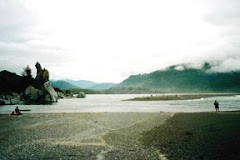by Felice Pace
In a
May 21st Public Safety Alert, the US Forest Service announced road closures on the Klamath National Forest due to storm damage. Some of these roads have failed time and again during large storms, delivering many tons of fine, salmon-killing sediment to our streams. Nevertheless, the agency is almost certain to reconstruct these roads using a permanent federal fund and NOT the Forest Service's own budget.
The Forest Service will reconstruct failed, salmon-killing roads without a meaningful environmental review or analysis to determine if the roads are really needed. In this manner, the US Forest Service has kept over 8,000 miles of dirt and gravel roads on the Klamath National Forest alone, even though the agency only has funds sufficient to maintain about 25% of those roads.
Research and on-the-ground experience has shown time and again that dirt and gravel roads which are not maintained to appropriate standards become chronic and episodic deliverers of fine sediment to our salmon streams. Yet Forest Service managers refuse to downsize the national forest road system to one that they have the funds to properly maintain.
To make this point hit home, below I give an example of a road system that has failed catastrophically time and again during major storm events and which Forest Service managers have reconstructed after each failure. These roads are located in the Walker Creek Watershed on the Oak Knoll and Happy Camp Ranger Districts of the Klamath National Forest.
The Walker Creek Roads failed catastrophically during the 1997 storm flood event. As part of those failures a full 1/2 mile of National Forest Road 46N65 collapsed into Grider Creek, delivering many toms of salmon-killing fine sediment to one of the Klamath's few remaining salmon strongholds.
Since 1997 these same roads have failed during several subsequent storm events. Each time Forest Service managers have used off-budget funds to reconstruct the roads.
Here's a photo showing road failure landslides in the Walker Creek Watershed after a storm event in 2017:
The Forest Service policy of reconstructing salmon-killing national forest roads after each major storm event is a recipe for permanently depressed salmon and steelhead runs. These roads also have
serious impacts on terrestrial wildlife. And that is why it is necessary for those of us who care about our fisheries and the health of our watersheds to continue to pressure Forest Service officials to downsize the national forest road system to one which can be properly maintained. Below is contact information for Klamath National Forest managers. Please take the time to urge them to remove salmon-killing roads.
.................
Rachel Smith, KNF Forest Supervisor
530-841-4502
rachel.smith@usda.gov
Natale Kelly, Scott/Salmon District Ranger
530-468-5351
| Roberto
Beltran, Happy Camp/Oak Knoll District Ranger |
| 530-398-4391 roberto.beltran@usda.gov |
| | | | | | | | | | | | | | | /530-493-2243 |
|
|
|
|
|
|
|
|


.JPG)

